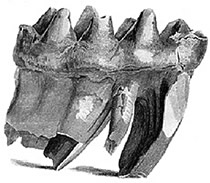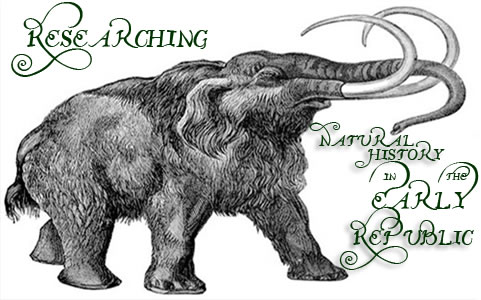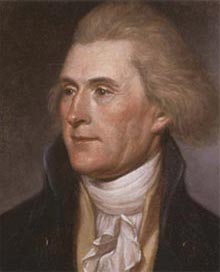Introduction
Natural history was an important aspect of the expansion of knowledge in the Early Republic.
Thomas Jefferson
Jefferson was a leading proponent of the study of natural history. As a member of the APS “committee to collect information respecting the past and present state of this country.” he was instrumental in procuring artifacts and skeletons of previously unknown animals like the Mammoth.
"You will, in the course of your journey, take notice of the country you pass through, it’s general face, soil, rivers, mountains, it’s productions animal, vegetable, and mineral so far as they may be new to us and may also be useful or very curious; the latitude of places or materials for calculating it by such simple methods as your situation may admit you to practice, the names, numbers, and dwellings of the inhabitants, and such particularities as you can learn of their history, connection with each other, languages, manners, state of society and of the arts and commerce among them." 1
Jeffersonians and Federalists began to struggle over the proper expression of knowledge. Jeffersonians focused on the description of the natural world while Federalists focused on classical knowledge. Many Federalists made fun of Jefferson and portrayed him as a fool with a shovel randomly digging throughout the backwoods of Virginia.2

Thomas Jefferson Fossil Collection : Housed at the Academy of Natural Sciences provides excellent examples of artifacts that document the begining of American paleontology. This is one example of the teeth of the American Mastadon.
More information here.
Extinction and ideas of God's universe
Lorem ipsum dolor sit amet, consectetuer adipiscing elit, sed diam nonummy nibh euismod tincidunt ut laoreet dolore magna aliquam erat volutpat. Ut wisi enim ad minim veniam, quis nostrud exerci tation ullamcorper suscipit lobortis nisl ut aliquip ex ea commodo consequat. Duis autem vel eum iriure dolor in hendrerit in vulputate velit esse molestie consequat, vel illum dolore eu feugiat nulla facilisis at vero eros et accumsan et iusto odio dignissim qui blandit praesent luptatum zzril delenit augue duis dolore te feugait nulla facilisi. Nam liber tempor cum soluta nobis eleifend option congue nihil imperdiet doming id quod mazim placerat facer possim assum. Typi non habent claritatem insitam; est usus legentis in iis qui facit eorum claritatem. Investigationes demonstraverunt lectores legere me lius quod ii legunt saepius. Claritas est etiam processus dynamicus, qui sequitur mutationem consuetudium lectorum. Mirum est notare quam littera gothica, quam nunc putamus parum claram, anteposuerit litterarum formas humanitatis per seacula quarta decima et quinta decima. Eodem modo typi, qui nunc nobis videntur parum clari, fiant sollemnes in futurum.
American Degeneracy
In America, therefore, animated Nature is weaker, less active, and more circumscribed in the variety of her productions; for we perceive, from the enumeration of the American animals, that the numbers of species is not only fewer, but that, in general, all the animals are much smaller than those of the Old Continent. --George Louis Leclerc, comte de Buffon (1707-1788)
Jefferson addressed the American Philosophical Society in 1797 discussing the discovery of a beast that was believed to be a large cat unknown to the scientific world. The Megalonyx or Great-Claw was believed to be three times the size of an African lion. This is significant because of it refutes the idea expressed by Comte de Buffon asserting that all species in the New World are less developed and inferior. This idea was known as American Degeneracy.
1 The Papers of Thomas Jefferson Digital Edition, ed. Barbara B. Oberg and J. Jefferson Looney. Charlottesville: University of Virginia Press, Rotunda, 2008. Canonic URL: http://rotunda.upress.virginia.edu/founders/TSJN-01-25-02-0569 [accessed 13 Feb 2010] Original source: Main Series, Volume 25 (1 January–10 May 1793)
2 Linda K Kerber, Federalists in Dissent; Imagery and Ideology in Jeffersonian America (Ithaca [N.Y.]: Cornell University Press, 1970).


